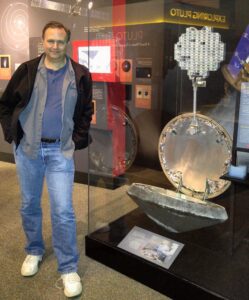
The aerospace industry in Utah and across the country is incredibly exciting right now. The expansion of private sector efforts, such as SpaceX lowering the cost of putting satellites up, along with NASA’s Artemis program moving closer and closer to putting astronauts back on the moon, creates a myriad of opportunities for qualified engineers. The mechanical engineering department is helping meet that need with new classes taught by industry professionals.
Dr. Douglas Buettner is an employee of The Aerospace Corporation (Aerospace), a member of the college of engineering’s Industrial Advisory Board, and now an adjunct professor in the Department of Mechanical Engineering. Buettner has more than 30 years of experience in engineering aerospace and software systems for the Department of Defense, NASA, and as an employee of Aerospace. In interacting with the department, Buettner saw an opportunity for more aerospace-focused courses and proposed using his expertise and the expertise of his colleague Dr. Mark Maier to provide it. These courses are being created with an eye on developing future engineers for programs Aerospace works on in Utah, as well as generally building the aerospace expertise coming out of the U.
To kick off this new set of aerospace courses, Buettner is teaching Space Mission Engineering this fall. He has also proposed teaching a software-intensive space systems engineering course in the future. Maier will be teaching a systems architecting course based on a book he co-wrote with one of Aerospace’s past CEOs, Dr. Eberhardt Rechtin, called “The Art of Systems Architecting.” There are also ongoing discussions on the possibility of developing additional courses.
“Personally, I just enjoy teaching these subjects,” said Buettner, “and it helps keep my broader engineering skills sharp. I’m personally happy to provide my experience to teaching our next generation of engineering leaders.”
The Space Mission Engineering course is designed to provide a broad overview of the engineering and physics topics required to put useful objects in space and have them meet their mission requirements. This challenging subject is geared to give students a taste of what it is like to engineer a space system. Buettner has created 16 potential space engineering topics for the students to design to, giving them a feel for the modern engineering steps used in creating these systems.
“Some of these problems are tricky for a reason,” said Buettner. “When you look at the history of human spaceflight, you rapidly conclude that engineers need to be able to ‘speak truth to power’ and ‘think for themselves’ as they may need to fall on their swords when safety is a concern. If I can teach just one engineer when they need to start raising the red flag on a human safety concern, then it’s well worth the effort.”
The software-intensive space systems engineering course will help students understand how to build systems relating to space efforts. Space ground systems are some of the most software-intensive systems we build as a nation today, while on the spacecraft side, there has been exponential growth since around 2000.
The department looks forward to hosting these courses and continuing to work with industry to develop courses that will give students relevant experience and knowledge to succeed in industry.